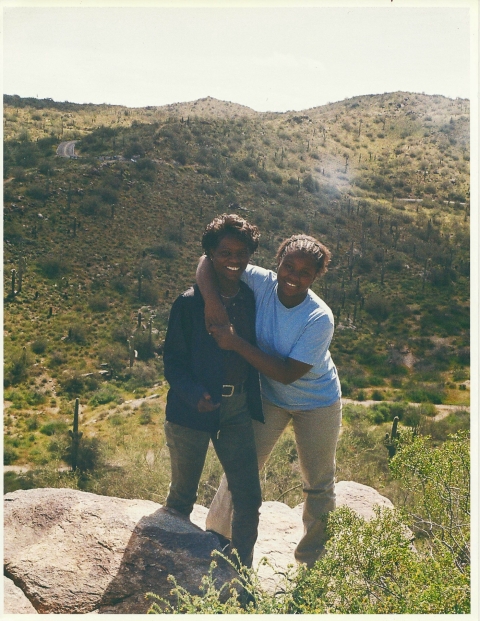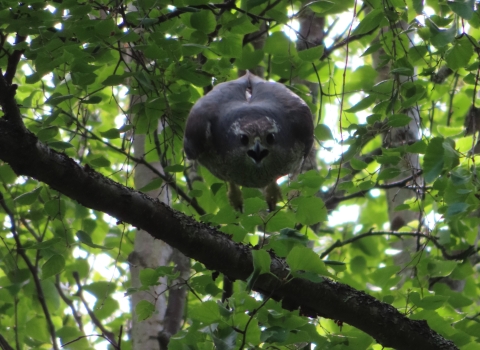Nicole Hams graduated from high school when she was 15 years old. An exceptional student, by 26, she had her master’s degree and Ph.D. in biochemistry and biophysics from Oregon State University. Hams had always excelled at school and science, but she did not initially plan the path she took or see herself in the field of conservation.
She calls her path untraditional. Home-schooled in her youth, she did not have many peers her own age. And as an only child, she experienced a lot of her life traveling and interacting with adults.
Her interest in wildlife began early. As a child, she was exposed to the outdoors while camping with her parents and spending time at Billy Frank Jr. Nisqually National Wildlife Refuge, not far from where she grew up in Puyallup, Wash. She enjoyed the wetlands there and remembers walking along the waterways and seeing the amphibians – she enjoyed the stillness that nature brought. She was glued to nature shows such as Wild Discovery, Going Wild with Jeff Corwin, and Zoboomafoo.
All this exposure planted the seeds for her growing interest in nature, conservation, and scientific curiosity.
She was also influenced by the people around her. Her parents instilled the importance of education. People she met in college and her professors helped guide her career and interest in conservation and science. And she was active in volunteer work; the people she met there helped her learn the importance of community and environmental stewardship.
But Hams did not initially see herself in the field of conservation or expect to work for the U.S. Fish and Wildlife Service. When asked what guided her to this path, she answers, “Serendipity.”
“The first time I held an animal larger than something you could put into a petri dish was during my Directorate Fellowship with the Fish and Wildlife Service,” Hams remembers. That animal was a Chinook salmon at Dworshak National Fish Hatchery in Orofino, Idaho.
Hams started her fellowship with the Service in 2017 while nearing the end of her doctoral program. For Hams, graduate school gave her the time and space to develop and refine her critical thinking skills, and she was well prepared to be a scientist. Her first post with the Service was in the Ecological Physiology program at Abernathy Fish Technology Center, and she enjoyed the work. Though Hams had always been interested in science, she also wanted to pursue outreach, to be involved with giving back and inspiring the next generation of “-ologists,” as she puts it.
She investigated various paths to doing outreach as a scientist, but had been discouraged by some, even from people in positions of prominent academic standing that, “You have to pick one. You can’t be both.”
Hams did not agree with that advice. She understands that though she may not be able to give 100% of herself to two things at the same time, “I can still be a scientist. It’s just a scientist in a different way.”
Hams has since made combining science with outreach a reality – a successful one at that. She leads education and outreach efforts out of the Columbia River Fish and Wildlife Conservation Office with partners and organizations around the Portland metropolitan area. She works closely with Portland public schools to facilitate “Salmon in the Classroom” curriculum and instruction for students and organize community outreach events. She also develops and manages internship opportunities for students on a regional and national level through involvement with MANRRS (Minorities in Agriculture, Natural Resources, and Related Science) and the Service’s Directorate Fellowship Program.
This unique exposure and opportunity for students and interns has proven to be impactful in making connections and marking a path for future scientists.
And perhaps that impact goes both ways. One day while teaching Salmon in the Classroom, a fourth grader caught Hams off guard.
“I was teaching a group of 4th graders about the salmon life cycle, and a young Black girl came up to me and she said, ‘I've never seen a Black scientist.’ And I remember, I just froze.”
Hams did not know how to respond this young girl. But she realized at that moment how important and meaningful it was for her to be visible, particularly for young kids.
“It really highlighted the importance of showing up for people who look like me, especially the younger generation,” she says. “Because having that representation, that's what inspires you – being able to see yourself reflected in that career.”
It is very likely that Hams’ presence was enough to make a lifelong impression on that little girl. And later, when the same classroom was highlighting a week of STEM – science, technology, engineering, and mathematics, on display were photographs of various scientists, and one of them was Hams holding that first Chinook salmon at Dworshak National Fish Hatchery. “It was one of those full circle moments,” she says.
Hams can relate to the impact she must have made on those students. She shares her personal experience of meeting Judy Gordon, the assistant regional director of the Fish and Aquatic Conservation program in the Pacific Region who has nearly 40 years of experience as a fish biologist and leader under her belt.
“When I first met Judy, I felt like that little Black girl in that 4th grade classroom. I'd never seen a Black fish biologist in a position of power before,” Hams says. She was blown away by Gordon’s presence.
“You can just see the amount of respect that her colleagues have for her, and learning how she navigates the intersection of her identities – as a Black woman in the Pacific Northwest, a doctor, a fish biologist, a leader – is inspiring. Judy has always been an advocate for me and the work that I do, even when I didn't know it.”
And Gordon has been a great advocate for Hams. She encouraged Hams to work at the Abernathy Fish Technology Center, to do science outreach in her capacity now, and is a strong supporter of the internship program Hams manages, putting financial resources behind it so the program can continue to onboard diverse interns and fishery professionals. Hams says she cannot think of a time Gordon has not been supportive of her work.
Hams also admires Gordon’s leadership and communication style. She never leaves a conversation with Gordon without fully understanding what she meant. “She is very clear. There are no gray areas, and she does it in such a beautifully articulate way that it's not offensive. It's not hurtful. It's just factual. It’s what you need to hear.
“She’s the boss of all bosses. That’s the kind of leader I hope to become.”
Looking at the bigger picture of representation and visibility in the Service, Hams applauds the Service for working to change the narratives we have around conservation, the narratives of who should be at the table, and working to bring forth policies and initiatives that encourage stewardship from all groups.
She emphasizes that BIPOC groups have always been involved in conservation of natural resources and land stewardship. She appreciates that the Service is recognizing these groups exist, making genuine efforts to listen and learn from them, and hopes there is continued support in the future.
Meanwhile in the Pacific Region, the work Hams and the Fish and Aquatic Conservation Program are doing toward educating youth and managing internships is making a real difference in this realm. Their work creates exposure for young students, gives guidance toward education and careers, and recruits interns who are equipped to do the job, while also paving a pathway to employment.
When asked what advice she’d give to future conservationists, Hams says without missing a beat, “Listen to me closely. YOU BELONG HERE. Conservation and environmental stewardship is for everybody.”







